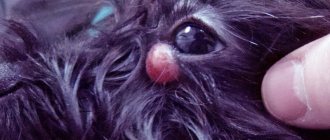Sometimes dog owners have to deal with the fact that soft growths appear on the body of their four-legged friends. These are benign formations, popularly called warts.
To find out what warts look like in dogs, just study the photos presented on this topic on the Internet.
Warts are often more of an aesthetic problem that does not require surgical intervention. However, if the formation is somehow damaged, it often has to be removed.
Cause of wart formation
Experts say that papillomavirus (as these formations are scientifically called) occurs due to weakened immunity in the animal.
The risk group includes the following categories of animals:
- small puppies and adolescents;
- elderly dogs;
- animals after illness, surgery, trauma, or who have experienced severe psychological stress;
- dogs with chronic diseases that occur in a latent form.
Preventive measures
Typically, papilloma virus occurs in a mild form and does not require additional medical treatment of the animal. Dogs that have already recovered from the virus receive immunity; the virus remains in the body, but warts do not appear. If the dog is not cured in time, it becomes a carrier of the virus and can infect people and other animals with which it comes into contact.
The main preventative method is to increase the animal’s immune system. To do this, you need a high-quality balanced diet, proper living conditions and moderate exercise. Particular attention should be paid to puppies and adult dogs, whose bodies are more susceptible to various infections. You also need to be examined by a doctor promptly, as some breeds are more likely to get warts than others.
Vaccination as a method to prevent the appearance of warts. Timely vaccination helps reduce the risk of the virus. These injections can also prevent squamous cell carcinoma in dogs. Any skin disease in a dog can cause serious illness. Most often these are benign formations that do not require surgical intervention. But, for this you need to consult a doctor, and not treat the animal using traditional methods.
At the same time, do not forget about the proper care and nutrition of the dog. Various reasons can affect the occurrence of warts, but they are easier to prevent and keep your pet healthy. To avoid complications, your dog needs to be examined and vaccinated.
Currently reading:
- 8 ways to treat papillomas on a dog’s body
- Primary and important symptoms of rabies in dogs
- Ways to manage parvovirus infection in dogs
- What to do if your dog gets distemper
Types of papillomas
In appearance, the formations to some extent resemble raspberries. They may differ in the following indicators:
Size. Most often these are small growths with a diameter of 0.5 to 5 mm. Although sometimes they go beyond these boundaries.
Color. Here you can find various shades of flesh, yellow, brown, gray.
Structure. There is no specific criterion here. Some growths may be simply dense, others - hard, while others, on the contrary, are soft.
Method of attachment to the skin. There are papillomas that are attached to a stalk or completely grow into the skin.
Any of them are dangerous for the animal. Warts on the stalk have a weak attachment, and as a result they can be damaged. The danger of ingrown ones lies in the possibility of their development into malignant formations.
Can the infection be transmitted to humans?
There is no convincing scientific evidence for this. However, this is hypothetically possible, because more than six hundred strains of human papillomavirus are known that can mutate and change.
- Therefore, it is possible that some of them can become universal, parasitizing both the human body and the animal body.
- If you have a papillomatous dog in your home, we recommend that you carefully observe personal hygiene and properly treat wounds and scratches.
In what areas of the body can papillomas form?
Papillomas mainly affect delicate skin. These are areas on the elbows and armpits, the groin area and inner thighs are at risk. Often the disease affects the mucous membranes. In some cases, this is the inner area of the mouth.
If left untreated, they may spread further. Thus, warts can form on a dog’s lip and face.
Main symptoms
Papillomas are small cone-shaped neoplasms of a soft and loose consistency, localized mainly on the oral mucosa, less often on the abdomen, paws, vulva and other parts of the body.
At the initial stage, the nodules have a smooth, even surface and a pinkish tint. As the disease progresses, papillomas become dirty gray in color and have jagged edges.
The size of warts varies, sometimes they can reach the size of a bean. Since papillomas are equipped with blood vessels, they are easily damaged and bleed.
Tumors can cause severe discomfort for your dog. It hurts her to chew and swallow, making it difficult to eat. An unpleasant odor emanates from the mouth. The animal refuses to eat, becomes lethargic, and subsequently becomes exhausted.
Why are warts dangerous?
The danger for the pet is the possibility of infection through damage to the papilloma.
Formations in the oral cavity are especially dangerous, since they are especially susceptible to mechanical damage during chewing food.
Papillomas formed on the skin of an animal most often cause severe itching, forcing the dog to scratch. As in the first case, this raises the possibility of damage and the risk of infection.
Caring for a puppy: a reminder for a novice dog breederHow to protect your dog from ticks: the best ways to protect yourself from tick bites
Toothpaste for dogs - review of manufacturers and the best products for cleaning dogs’ teeth at home (85 photos and videos)
Risk group and routes of transmission
The risk of infection is increased in:
- older dogs and puppies;
- animals with weak immunity, reduced due to a chronic disease or recent illness;
- pets belonging to pugs, cocker spaniels, spitz, miniature schnauzers and terriers.
The appearance of papillomas is due to:
- using a contaminated syringe during vaccination;
- interaction with personal belongings of an infected animal;
- direct contact with a sick dog;
- non-sterile instruments used for grooming.
Infection occurs from warts located on the cheeks and mucous membranes (lips, mouth).
If papillomas affect the ears, paws or neck of a pet, then it does not pose a danger to other animals.
As an animal ages, it becomes more susceptible to the virus.
Treatment of warts in dogs
At the end of the incubation period, the disease progresses over 3 months, after which remission can be expected.
In this case, one cannot hope for independent recovery. The animal needs treatment.
The main principles are the use of immunostimulating drugs, a properly balanced diet and providing the pet with complete rest.
But the treatment does not end there. If the formation causes itching, this suggests the use of antihistamines.
If a dog has a wart scratching on its paw or other external part of the body, it is necessary to use an anti-inflammatory ointment.- Curtains with eyelets - what is their feature? Photo of beautiful design
- Shoes for dogs - sizes, features of use and training for shoes of different breeds (85 photos)
- How to cut dogs - step-by-step clear instructions for beginners on how to cut a haircut correctly at home (video + 90 photos of haircuts)
In general, all types of treatment are divided into:
- Medication.
- Surgical.
- Folk remedies.
What are papillomas?
The reasons for the formation of papillomas in our little brothers are viruses. Currently, eight types of pathogen are distinguished. They are the cause of the development of papillomatosis - a disease as a result of which papillomas develop on the mucous membranes and skin - growths in the form of a small process, a polyp. Certain strains of the virus can be transmitted from a sick to a healthy individual.
What are papillomas?
Papillomas are single growths, and they can have different sizes. In appearance, the neoplasms look like large warts with a loose structure and a cone-shaped shape. There are blood vessels inside the growths, so they are often injured, bleed and hurt.
If a pet has a lot of such growths, a diagnosis of papillomatosis is made. Multiple accumulations of such warts are not uncommon in dogs. Such neoplasms are benign and most often appear in young individuals. Neoplasms on the mucous membranes of the mouth (ulcers, gums, cheeks, lips) are contagious and are transmitted from a sick pet to a healthy pet.
At a more mature age, pathological formations develop in the ears, eyes, neck, paws, and eyelids. These are denser, more mature growths that are not contagious to other dogs.
Drug treatment
This type of removal of papillomas involves treatment with novocaine. This can be done in several ways:
Intravenously. The dosage and frequency of procedures are prescribed by a veterinarian.
Subcutaneously. The medicinal composition is injected directly under the base of the papilloma. The whole hen requires 2 to 3 injections with a doctor-prescribed interval between injections.
Intramuscularly. The animal is injected with novocaine every three days. The dosage is calculated as follows: 1 ml of the drug per 1 kg of animal body weight.
Traditional medicine
Traditional medicine offers the following treatment methods:
- Intravenous injections of novocaine. A solution with a concentration of 0.5% is used. Three injections are given at intervals of three days. The dose is selected individually, taking into account the dog’s weight.
- Novocaine injections into the base of the papule. The operation is performed three times with a break of two to three days.
- Injections of novocaine and iodoform ether. A single injection is made into the base of the papilloma, and then iodoform ether is injected.
- Taking fosprenil. A new drug that is effective against most strains.
- Novocaine blockade. Placed under the jugular process.
- Immunomodulatory drugs. Prescribed to enhance immunity.
- Antiverrucin paste. The tumor is treated regularly until the growth is completely rejected.
- Immunoparasite with comedones. Injections are carried out according to a certain scheme.
If the treatment involves the use of pastes or ointments, it is recommended to put a cardboard collar on the pet so that it does not lick the medicine.
Surgical removal of papillomas is not always appropriate. As practice shows, this can lead to an acceleration of the spread of the disease. But if the growth is large and leads to difficulty in eating and swallowing, they resort to removing the tumor using minimally invasive methods. Apply:
- Cryodestruction. As a result of exposure to low temperatures, tumor cells die and are rejected.
- Electrocoagulation. Pathological cells die under the influence of a current of a set frequency.
- Laser removal. The focused laser beam performs a directed action.
Surgical removal
This treatment includes surgery to remove the papilloma and a course of rehabilitation therapy.
- Dandruff in dogs - causes of occurrence, advice on choosing a treatment method and prevention of dandruff (100 photos + video)
- Shampoos for dogs - a review of the most effective and best dog hair care products in 2022 (105 photos)
- Muzzle for dogs - tips on how to choose and what is the best muzzle for dogs to buy (110 photos)
It is worth noting that this method does not always lead to the desired result. Surgery and prior anesthesia contribute to a significant decrease in the animal’s immunity.
And this, in turn, can lead to the emergence of new formations. Therefore, surgery should be performed in extreme cases.
Removing warts from dogs using traditional methods
This method is not only effective, but also safe for the patient, since drugs of natural origin are used here.
Treatment can be carried out with self-prepared mixtures. To do this, prepare one of the following compositions:
- chopped garlic mixed with lemon juice;
- baking soda mixed with castor oil;
- honey combined with a mixture of flaxseed and castor oil.
You can rub the affected area with apple cider vinegar or celandine juice.
In all cases, it is necessary to prevent the animal from licking the drug. To do this, you need to either apply a bandage to the treated area of the body, or put a “collar” on the dog at night.
Along with commonly used treatment methods, alternative ones are often used.
Vaccination
Annual vaccination will help protect against the appearance of papillomavirus. It is carried out under sterile conditions.
- To make it, papillomatous tissue from the affected area is used.
- The injection is performed subcutaneously twice.
- The interval between sessions is 7-10 days.
- Improvements are observed after three weeks.
Burnout
Used only for pedunculated papillomas. In this case, the base and body of the wart are carefully lubricated with iodine and bandaged tightly with a strip of natural fabric.
The product applied in this way must be left on for 3-4 days. After this, the papilloma often disappears.If desired, iodine can be replaced with a specially prepared pharmaceutical ointment based on benzene.
In any case, it is necessary to protect the surface of the body near the papilloma from burns. For this purpose, the adjacent area of skin must be pre-treated with any fatty composition: cream, Vaseline or olive oil.
Freezing
With this method of treatment, dry ice is applied directly to the papilloma 2-3 times a day for 30-60 seconds. After a week, you can notice a significant decrease in formation. After a few more days it most often disappears.
To ensure the effectiveness of a particular treatment method, it is advisable to read the instructions in detail and, if possible, study the presented photos of warts on a dog before and after the course of treatment.
Consequences of the disease
If recovery occurs on its own, the pet is no longer susceptible to the disease. However, it becomes a carrier of the disease, being dangerous for weakened dogs.
When deciding to carry out treatment at home on your own, it is worth carefully observing the animal. If you cannot achieve the desired effect, the growths grow, affecting more and more healthy areas, you should seek qualified help. Formations on the body cause anxiety in the dog; he will try to scratch or chew them. Papillomas under the collar are more difficult to treat at home.
With the right approach and proper attitude, papillomas will disappear quickly, will not cause consequences, and will not bother your pet in the future.
Photos of warts in dogs
Help the project, repost

0











